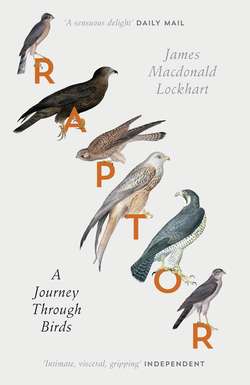Raptor: A Journey Through Birds

Реклама. ООО «ЛитРес», ИНН: 7719571260.
Оглавление
James Lockhart Macdonald. Raptor: A Journey Through Birds
Copyright
Contents
Epigraph
Hen Harrier
Merlin
Golden Eagle
Osprey
Sea Eagle
Goshawk
Kestrel
Montagu’s Harrier
Peregrine Falcon
Red Kite
Marsh Harrier
Honey Buzzard
Hobby
Buzzard
Sparrowhawk
Bibliography
Acknowledgements
About the Publisher
Отрывок из книги
Title Page
.....
This morning the wind has shed some of its weight. The curlew’s song has more reach. A male harrier is coming in from the west, lucent against the heather. He is flying more quickly than usual, keeping a straight line, heading for the nest that sits in the lap of a hill amongst thick tussocks of moor grass. Now the female is up and rising to greet him, rushing towards the male. She is so much larger than him, her colours so markedly different, her tawny browns set against his smoking greyness. For centuries the male and female hen harrier were thought to be a different species, and this morning she might have been a larger hawk about to set upon the smaller male. But, at the last moment, she twists onto her back beneath the male and their talons almost brush. The male releases something from his feet and she seizes and catches it in mid-air. All of this happens so quickly and the movement is astonishing for its speed and precision. I cannot make out what it is the male has passed to her but the female has flipped instantly upright again and is rising towards the male once more. Again, at the last moment, she twists onto her back but this time nothing is passed between them. I’m puzzled why she repeats the manoeuvre like this. Perhaps the male still has something in his talons? But I am lucky to witness it again, it is like an unexpected echo and gives me the chance to replay the whole extraordinary exchange. I stay with the female and watch her drop into the heather, where she begins to feed.
Why do hen harriers make this beautiful, acrobatic food pass? When she is incubating, then brooding and guarding the young at the nest, the female is dependent on the male to provide food for her and the chicks. Later, when the chicks are closer to leaving the nest, she will resume hunting. But until then the male must work overtime to provide for the brood and his mate. Polygamous males, common on Orkney, are required to ratchet up their hunting, providing for two, sometimes three, separate nests (the record on Orkney is seven). Nesting in tall dense vegetation on the ground, the food pass is the most efficient way of securing the exchange of prey whilst also distracting from the precise location of the nest, the pass often taking place some distance from the nest itself, which helps to avoid drawing its attention to predators. I wonder if the female ever drops the pass from the male. The hen harrier is so supremely agile, their long legs have such reach, it seems like the male could lob the most awkward pass at his mate and she would still pluck the prey out of the air with all the time to spare.
.....